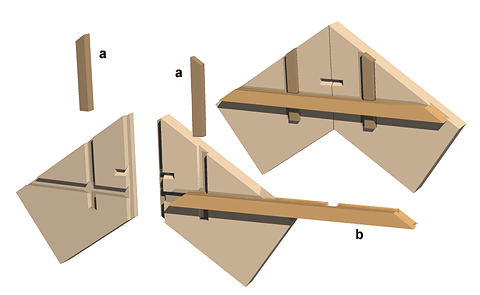|
||
 |
||

a) *shachi 車知 b) *suitsuki arizan 吸付蟻桟
(C)2001 Japanese Architecture and Art Net Users System. No reproduction or republication without written permission.
掲載のテキスト・写真・イラストなど、全てのコンテンツの無断複製・転載を禁じます。
|
||||||
| hafuogami 破風拝 | ||||||
| KEY WORD : architecture / general terms | ||||||
| Also called hafugashira 破風頭 or hafu-no-ogami 破風の拝. The joint between two bargeboards hafu-ita 破風板 (see *hafu
破風). The joint used to connect the two parts of the bargeboard where they form
a peak was relatively simple from the end 7c-12c. A rectangular piece was cut
out of the top of one bargeboard and the same size cuts were made on each side
of the top of the other bargeboard. The central, extended piece fitted snugly
into the cut-out on the peak of the other bargeboard. The two were secured by
a wooden pin that penetrated from the exterior face to beyond the interior side.
Example: Houryuuji *Kondou 法隆寺金堂 (rebuilt 693), Nara. After the beginning of the 13c
more complex methods of joinery were devised. Generally, a mortise and tenon with
haunched keys daimochi shachitsugi 台持車知継 were employed. Sometimes a tenon
and mortise joint was used at the peak, but a wooden scab *suitsuki arizan
吸付蟻桟 was attached to the interior face by means of wooden pins *shachi
車知 that were pounded into slots prepared at the top of the bargeboards. These
pins secured the scab, and the entire arrangement pulled the bargeboards tightly
together at the peak. |
||||||
 a) *shachi 車知 b) *suitsuki arizan 吸付蟻桟 |
||||||
| REFERENCES: | ||||||
| EXTERNAL LINKS: | ||||||
| NOTES: | ||||||
(C)2001 Japanese Architecture and Art Net Users System. No reproduction or republication without written permission. 掲載のテキスト・写真・イラストなど、全てのコンテンツの無断複製・転載を禁じます。 |
||||||